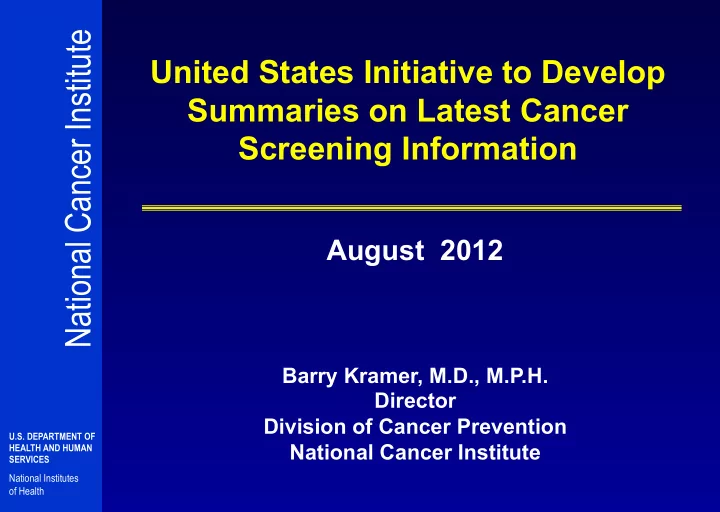

National Cancer Institute United States Initiative to Develop Summaries on Latest Cancer Screening Information August 2012 Barry Kramer, M.D., M.P.H. Director Division of Cancer Prevention U.S. DEPARTMENT OF National Cancer Institute HEALTH AND HUMAN SERVICES National Institutes of Health
Conflicts of Interest • I do not have any financial conflicts of interests. • All opinions expressed are my own and do not represent official statements of the U.S. government.
NCI Communications Resources Fact sheets/Q & As, news summaries, PDQ statements, NCI Cancer Bulletin • Online at http://cancer.gov • By phone at 1-800-4- CANCER (1-800-422-6237) • Social media channels, including Facebook, Twitter, and YouTube • In English and Spanish
PDQ Editorial Boards PDQ Editorial Boards evaluate published results of cancer research conducted worldwide and assess strength of the evidence regarding cancer-related interventions PDQ Editorial Boards do not formulate practice guidelines or make treatment recommendations PDQ Editorial Boards are not formal advisory boards to NCI and do not formulate policy for Institute ~15% government, 85% non-government
Physician Data Query (PDQ): � Level of Evidence � for Cancer Screening Definition: certainty of the editorial board � s estimate of the health effects of implementing an intervention Steps: I. Description of the evidence (5 Domains) II. Summary assessment for both benefits and harms
Description of Evidence in PDQ: Five Domains 1. Study design: ranked by design strength 2. Internal validity: � quality � of execution within study design (good, fair, poor) 3. Consistency (coherence) /volume of evidence – One vs. multiple studies – Small vs. large studies – Consistent direction of outcomes 4. Magnitude of effects: prefer absolute vs. relative effects – Change from 1% to 0.5%, or from 4/1000 to 2/1000 [Not: 50% decrease] 5. External validity (good, fair, poor) – Applicability in usual practice with same effect?
Randomized Controlled Double Blind Studies Randomized Controlled Studies Cohort Studies Case Control Studies Case Series Case Reports Ideas, Opinions
Internal Validity Criteria for Randomized Internal Validity Criteria for Randomized • • Initial assembly of compatible groups : – For RCTs: adequate randomization, including concealment – For cohort studies: consideration of potential confounders with adjustment in the analysis • • Maintenance of comparable groups (attrition, crossovers, adherence, contamination) • • Important differential loss to follow-up; overall high loss to follow-up • • Measurements: Important differential loss to follow-up; overall high loss to follow-up equal, reliable, and valid (includes masking of outcome assessment) • Clear definition of interventions • Analysis: All important outcomes considered adjustment for potential confounders for cohort studies, or Source: R. Harris et. al., Am J Prev Med 2001
Summary Assessment of Evidence Level of certainty (solid, fair, inadequate) of direction and Level of certainty (solid, fair, inadequate) of direction and magnitude of health effects of widespread implementation Example: Prostate cancer screening – Benefit: Evidence is inadequate to determine whether screening for prostate cancer with PSA or digital rectal examination reduces mortality for prostate cancer … . – Harm: Based on solid evidence, screening with PSA or DRE detects some prostate cancers that would not have caused important clinical problems, leading to some degree of over treatment. Based on good evidence, treatments result
Thank you
Recommend
More recommend